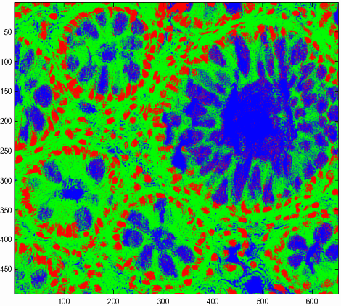Systems of interacting agents arise in a wide variety of disciplines, including Physics, Biology, Ecology, Neurobiology, Social Sciences, Economics, … Agents may represent elementary particles, atoms, cells, animals, neurons, people, rational agents, opinions, etc…
The understanding of agent interactions at the appropriate scale in these systems is as fundamental a problem as the understanding of interaction laws of particles in Physics.
We propose a non-parametric approach for learning interaction laws in particle- and agent-based systems, based on observations of trajectories of the states (e.g. position, opinion, etc…) of the systems, with the crucial assumption (for now) that the interaction kernel depends on pairwise distances only. Unlike recent efforts, we do not require libraries of features or parametric forms for such interactions.
Some videos of interacting particle/agent systems. If they do not start automatically, please right click and start the videos. Insets: Cucker-Smale flocking (left), fish mills (right).
In each inset: Left: trajectories of true system, from an initial condition used during the training phase (top) and a new random initial condition (bottom). Right: trajectories of the system with the learned interaction kernel, started from the same initial conditions as the corresponding system on the left.
More examples, movies, etc…available on M. Zhong’s webpage
CONFERENCES/WORKSHOPS
Second Symposium on Machine Learning and Dynamical Systems, Fields Institute, Toronto, Sep. 21-25, 2020
Understanding Many-Particle Systems with Machine Learning, IPAM, Fall 2016
Symposium on Machine Learning and Dynamical Systems, Imperial College London, Feb. 11-13, 2019
Validation and Guarantees in Learning Physical Models: from Patterns to Governing Equations to Laws of Nature, IPAM, Fall 2019, part of the program Machine Learning for Physics and the Physics of Learning
A collaboration with Natalia Trayanova’s lab: we help developing novel techniques in computational mathematics and machine learning to improve the construction of digital twins and improve their ability to model and predict cardiac events.
A list of relevant publications on this collaboration is here: it includes works on using deep learning techniques to perform segmentation of the myocardium, of the scarred portion thereof, and to extract clinical features; work on predicting sudden cardiac death from enhanced cardio-MRI images and clinical features; and works developing novel machine learning techniques for solving the electrophysiology equations faster across different domains (the patient-specific hearts), based on deep learning and harmonic analysis on meshes.
- Multiscale SVD and Intrinsic Dimensions
- Multiscale Geometric Methods for Data Sets I: Multiscale SVD, Noise and Curvature, A. V. Little, M. Maggioni, L. Rosasco. This paper summarizes the work in A.V. Little’s thesis (May 2011) on multi scale singular values for noisy point clouds. This extends the analysis of the constructions and results in our previous work Multiscale Estimation of Intrinsic Dimensionality of Data Sets (A.V. Little and Y.-M. Jung and M. Maggioni, Proc. AAAI, 2009, and see a presentation by A.V. Little here) and Estimation of intrinsic dimensionality of samples from noisy low-dimensional manifolds in high dimensions with multiscale SVD (A.V. Little and J. Lee and Y.-M. Jung and M. Maggioni, Proc. SSP, 2009}. Appears in A.C.H.A. in Mar ’16 almost 4 years after submission.
- Multiscale Geometric Methods for estimating intrinsic dimension, A.V. Little, M. Maggioni, L. Rosasco, Proc. SampTA 2011
- Multiscale geometric wavelets for the analysis of point clouds, G. Chen, M. Maggioni, Proc. CISS, 2009
- Geometric Multi-Resolution Analysis (GMRA) and Dictionary Learning:
- Dictionary Learning and Non-Asymptotic Bounds for Geometric Multi-Resolution Analysis, with S. Minsker and N. Strawn, in Proceedings of the second “international Traveling Workshop on Interactions between Sparse models and Technology”, 2014, as well as here
- Multiscale Dictionary Learning: Non-Asymptotic Bounds and Robustness, M. Maggioni, S. Minsker, N. Strawn, to appear in J.M.L.R., submitted in 2014
- With connections to compressed sensing and estimation of probability measures: A Fast Multiscale Framework for Data in High Dimensions: Measure Estimation, Anomaly Detection, and Compressive Measurements, G. Chen and M. Iwen and S. Chin and M. Maggioni, Visual Communications and Image Processing (VCIP), Nov. 2012 IEEE (submitted April 2012, published version available here).
- With connections to compressed sensing: Approximation of Points on Low-Dimensional Manifolds Via Random Linear Projections, M. Iwen, M. Maggioni. Appears here in Information and Inference, 2, 2013.
- With connections to learning dictionaries for multiscale patches: Multiscale dictionaries, transforms, and learning in high-dimensions, S. Gerber, M. Maggioni, Proc. SPIE 8858, Wavelets and Sparsity XV, 88581T, 2013.
- Multiscale Geometric Methods for Data Sets II: Geometric Wavelets, W.K. Allard, G. Chen, M. Maggioni , Appl. Comp. Harm. Anal., Vol. 32(3), May 2012, 435-462. This is a detailed and improved construction for geometric wavelets for point clouds, originally introduced in the 2010 conference paper here.
- With applications to model reduction and control: Geometric Multiscale Reduction for Autonomous and Controlled Nonlinear Systems, J. Bouvrie and M. Maggioni, IEEE Conference on Decision and Control (CDC), 2012.
- Multiscale Geometric Dictionaries for point-cloud data, G. Chen, M. Maggioni, Proc. SampTA 2011
- Modeling with multiple planes:
- Multiscale Analysis of Plane Arrangements, G. Chen, M. Maggioni, CVPR, 2011. See also the corresponding poster and code on G. Chen’s webpage.
Diffusion wavelets generalize classical wavelets, allowing for multiscale analysis on general structures, such as manifolds, graphs and point clouds in Euclidean space. They allow to perform signal processing tasks on functions on these spaces. This has several applications. The ones we are currently focusing on arise in the study of data sets which can be modeled as graphs, and one is interested in learning functions on such graphs. For example we can consider a graph whose vertices are proteins, the edges connect interacting proteins, and the function on the graph labels a functionality of the protein. Or each vertex could be an image (e.g. a handwirtten digit), the edge connect very similar images, and the function at each vertex is the value of digit represented by that vertex.
In classical, one-dimensional wavelet theory one applies dilations by powers of 2 and translations by integers to a mother wavelet, and obtains orthonormal wavelet bases. The classical construction has been of course generalized in many ways, considering wide groups of transformations, spaces different from the real line, such as higher-dimensional Euclideanspaces, Lie groups, etc…Most of these constructions are based on groups of geometrical transformations of the space, that are then applied (as a “change of variable”) to functions on that space to obtain wavelets.
On general graphs, point clouds and manifolds there may not be nice or rich groups of transformations. So instead of assuming the existence of these “symmetries” we directly use semigroups of operators acting on functions on the space (and not on the space itself). We typically use “diffusion operators”, because of their nice properties. Let T be a diffusion operator on a graph T (e.g. the heat operator). In many cases, our graph will be a discretization of a manifold. The study of the eigenfunctions and eigenvalues of T is known as Spectral Graph Theory and can be viewed (for our purposes) a generalization of the classical theory of Fourier series on the circle. The advantages of wavelets and multi-scale techniques over classical Fourier series are well known. So it is natural to attempt to generalize the wavelet theory to the setting of diffusion operators on graphs. Following Stein, we take the view that the dyadic powers of the operator T establish a scale for performing multiresolution analysis on the graph. In the paper, “Diffusion Wavelets,” we introduce a procedure for construction scaling functions and wavelets adapted to these scales.
Index
- Papers
- Matlab code
- Talks
- Sketch of the Construction
- Examples
- Diffusion Wavelet Packets
- Local Discriminant Bases with Diffusion Wavelet Packets
Papers
- Diffusion-driven Multiscale Analysis on Manifolds and Graphs: top-down and bottom-up constructions, M Maggioni, A Szlam, RR Coifman, JC Bremer, Proc. SPIE Wavelet XI, August 2005.
- Biorthogonal Diffusion Wavelets for Multiscale Representations on Manifolds and Graphs, M Maggioni, JC Bremer, RR Coifman, A Szlam, Proc. SPIE Wavelet XI, August 2005.
- Diffusion Wavelet Packets, JC Bremer, RR Coifman, M Maggioni, A Szlam, submitted, August 2004.
- Diffusion Wavelets, RR Coifman, M Maggioni, submitted, August 2004. ACHA special issue on Diffusion Maps and Wavelets (July 2006). If this link does not work, start from ACHA home page (see the most downloaded papers).
- Other relevant publications
Sketch of the Construction
In several applications there is a need to organize structures in a multi-resolution fashion, in order to process them, understand them, compress them etc…Maybe the most classical example is given by Fourier analysis, where different resolutions correspond to different frequency bands in which a signal can be analyzed. However, wavelets allow one to perform a multi-resolution analysis in a somehow stronger and better organized way in the spatial domain. The construction of wavelets in Euclidean spaces is by now in many ways quite well understood, even if interesting open questions remain for higher-dimensional wavelet constructions. Wavelets have found also wide applications in numerical analysis, both as mathematical foundation of Fast Multipole Methods, and by providing bases for Galerkin methods. Already in this latter setting, though, higher flexibility has been required than low-dimensional Euclidean wavelets, since multi-resolution are needed on rather general domains and manifolds. Both the Fast Multipole Methods and the Galerkin wavelet methods are not very well adapted to the operator, and only through some efforts are they adapted to the geometry of the domain/manifold. Finally, we want to mention the setting of Spectral Graph Theory, where one can naturally do Fourier analysis through the Laplacian of a graph, and several multi-scale constructions, for use in a variety of applications, are still quite ad hoc.
In the paper “Diffusion Wavelets” we propose a construction of wavelets on discrete (or discretized continuous) graphs and spaces, that are adapted to the “geometry” of a given diffusion operator T, where the attribute “diffusion” is intended in a rather general sense. The motivation for starting with a given diffusion operator is that in many cases one is interested in studying functions on the graph/space, and hence it seems natural to start with a local operator generating local relationships between functions. Powers of the operator propagate these relationships further away till they become global.
If the spectrum of T decays, large powers have low-rank, and hence are compressible. For example we can think of the range of high power of T as being essentially spanned by very smooth functions with small gradient, or even band-limited functions. It is natural to take advantage of this, and compress the ranks of (dyadic) powers of the operator, thus obtaining a decreasing chain of subspaces, which can be interpreted as scaling function approximation spaces. The difference between these subspace can be called wavelet subspaces. The construction of the basis elements is non-trivial: we show one can build orthonormal bases of scaling functions and wavelets, with good localization properties in about order n(log n)^2, even if the constants are still big and their improvement is of great practical significance and is being investigated.
The algorithm proceeds by applying T^(2^j), expressed on the basis of orthonormal scaling functions spanning V_j, then orthogonalizing the resulting set of vectors, discarding the ones not needed to span (numerically) the same subspace, and so on. Hence the orthonormalization step encapsulate the downsampling step.
Our construction works on a Riemannian manifold, with respect to, for example, the Laplace-Beltrami diffusion on the manifold; on a weighted graph, with respect, for example, to the natural diffusion induced by the weights on graph.
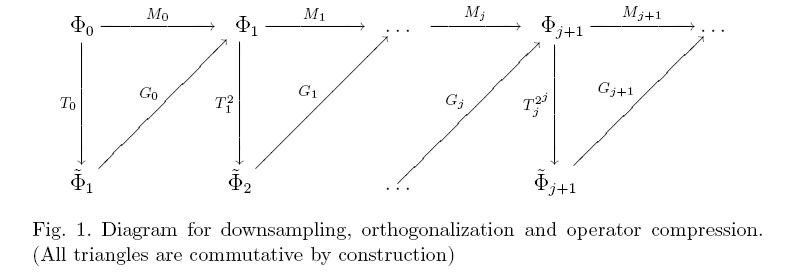

Examples
Homogeneous diffusion on a circle
The first example is a standard diffusion on the circle: our set is the circle sampled at 256 points, an initial orthonormal basis is given by the set of 256 delta-functions at each points, and the diffusion is given by the standard homogeneous diffusion on the circle. In the picture, we plot several diffusion scaling functions in various scaling function spaces. The finest scaling functions are the given delta-functions. These diffuse in ‘triangle functions’ (linear splines): these are orthonormalized into a (non-translation invariant) basis of ‘triangle functions’ and linear combinations of ‘triangle functions’. Those are diffuse again twice etc.. The coarse scaling function spaces are spanned by the first few top eigenfunctions of the diffusion operator, which are simply trigonometric polynomials with small frequency. The algorithm still tries to build well-localized scaling functions out these trigonometric polynomials (see e.g. V_9, V_10, V_11) when possible.

On the left we plot the compressed matrices representing powers of the diffusion operator, on the right we plot the entries of the same matrices which are above precision. The initial powers get fuller because the spectrum of the diffusion is slowly decaying. It is enough to consider, instead of the given diffusion, a small power of it to avoid this partial fill-up.
Non-homogeneous diffusion on the circle
We consider a circle as before, but now the diffusion operator is not translation invariant or homogeneous: the conductivity is non-constant and is depicted in the figure in the top-left position. Think of the circle of different materials, which is most conductive at the top and least conductive (almost insulating material) at the bottom. In the top right picture we represent some scaling functions at level 15, so by construction/definition, these scaling functions span the range of T^(2^16-1). Observe that the “scale” of these scaling functions is far from uniform if we measure it in a translation invariant way (for example with standard wavelets on the circle, or with the diffusion wavelets of the previous example). However this is exactly the scale at which the corresponding power of T is operating: at the top of the circle the diffusion acted fast , the numerical rank of the operator restricted to that region is very small, and the scaling functions are trivial there; on the bottom part of the circle, this power of T is still far from trivial, since there the diffusion is much slower, and scaling functions exhibit a more complex behavior (they still contain local high-frequency components).
In the second row we show how one can compute an eigenfunction of the compressed operator and extend it back to the whole space, with good precision.
In the third row we show the entries above precision of a power of the operator (left); on the right we show a “diffusion scaling function” embedding, which shows that points at the bottom of the circle have a large “diffusion distance” (it is hard/takes a long time to diffuse from one to the other) while points at the top have a small diffusion distance. Diffusion distance in original space is roughly Euclidean distance in this “diffusion scaling function” embedding.
Diffusion on a graph of 3 Gaussian clouds
In this example we consider the graph induced by points randomly distributed according to three Guassian random variables centered at different points. A graph is associated to these points, by putting edges between close-by points, with weights which are an exponentially decays function of the distances between the points.
The picture top-left shows the points, the picture top center shows the image of the points under the Laplacian eigenfunction map, the remaining figures show some diffusion scaling functions and wavelets, hinting at how they could be used to localized the analysis of this graph.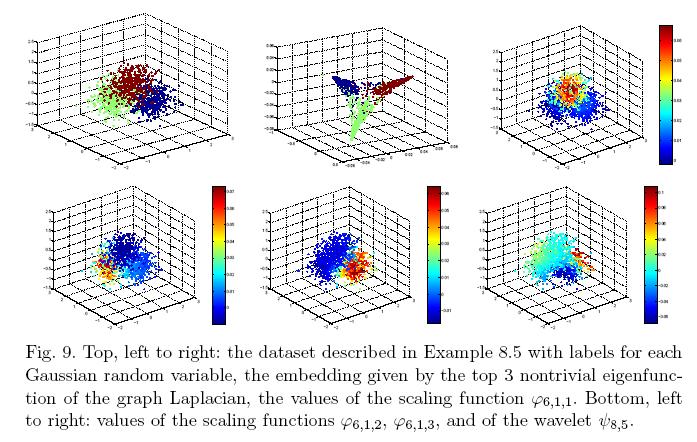
Diffusion a dumbbell-shaped manifold
We consider a dumbbell-shaped manifold, with diffusion given by (a discrete approximation to) the Laplace-Beltrami operator.
The picture shows different scaling functions and wavelets at different scales, on this manifold.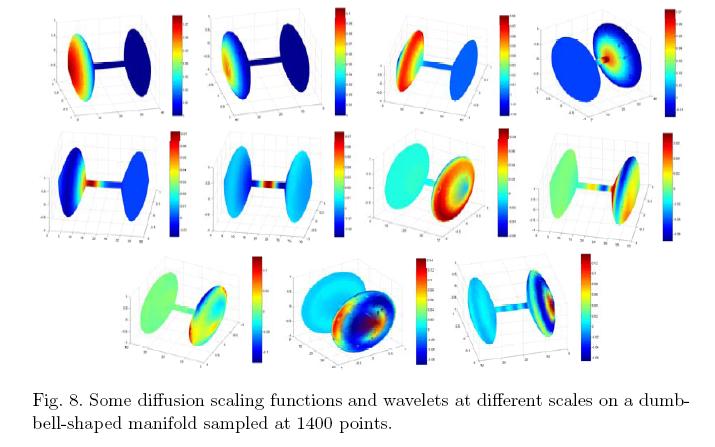
Extension outside the set
We also propose an algorithm for extending scaling functions and wavelets from the data set. In the figure we show the extension of some scaling functions from the set (left) to many points randomly generated around the set.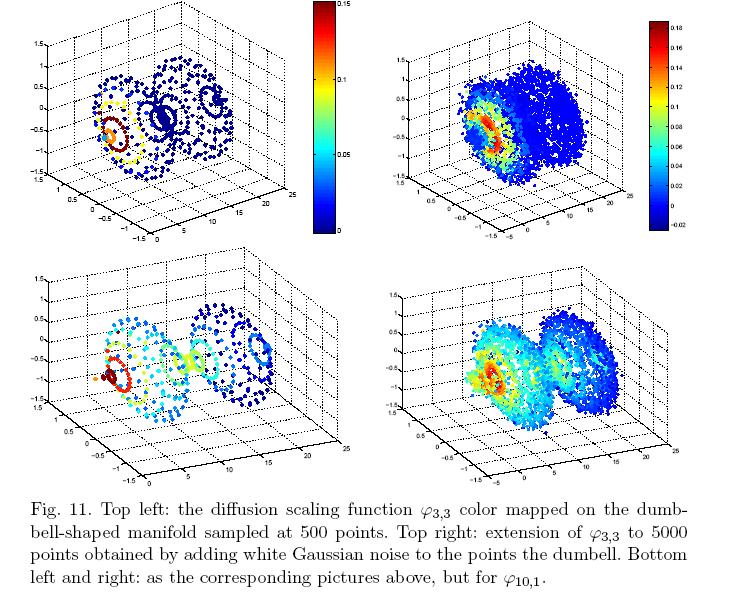
Diffusion Wavelet Packets
Diffusion Wavelet Packets can be constructed by further splitting the wavelet subspace further, as in the classical case.
Local Discriminant Bases with Diffusion Wavelet Packets
We consider two classes of functions on the sphere, and the problem of learning a good set of features such that the projection on them allows for good discrimination between the functions of the two classes.
Functions of class A are build as the superposition of three ripply functions, with equi-oriented ripples of the same frequency, centered around three points moving slightly in a noisy way, and two Guassian bumps acting as decoys, which are non-overlapping with the three ripply functions. Functions of class B are similar but one (randomly chosen) ripply function has ripples in a different direction than the other two.
Running CART on the original data has an error of 48%, running it on the top 40 LDB features leads to an error of about 12.5%, and running it onto the top discriminating eigenfunctions leads to an error of about 18%.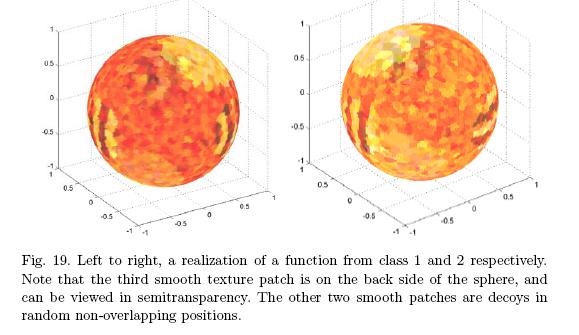
As a second example of local discriminant basis, we consider the following two classes of functions. We fix a direction v, and slightly perturb it with random Gaussian noise. Around that direction we create a ripply spherical cap, with one or two oscillation depending on the class. We add then 5 non-overlapping ripply functions, acting as decoy, randomly on the sphere.
CART run on the original data has an error of about 17.5%, CART on the top 20 LDB features has an error of about 3.5%, and CART on the first 300 eigenfunctions has an error of about 31%.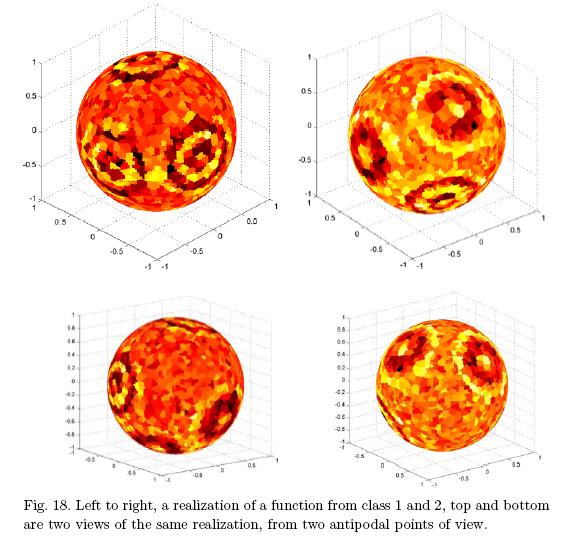
Diffusion geometry refers to the large-scale geometry of a manifold or a graph representing a data set, which is determined by long-time heat flows on the manifold/graph/data set.
A multiscale analysis, that includes all scales and not just large scales, is possible with diffusion wavelets.
This behavior can be accurately described by the bottom eigenfunctions of the Laplacian operator on the manifold or on the graph (or data set). Moreover, these eigenfunctions can be used to define an embedding (sometimes called eigenmap) of the manifold or graph into low-dimensional Euclidean space, in such a way that Euclidean distances in the range of the eigenmap correspond to “diffusion distances”; on the manifold or graph. Techniques based on eigenvectors of similarity matrices (which are related to the Laplacian have been used successfully for some time in several problems in data analysis, segmentation, clustering, etc…
These connections, and connection to differential-geometric structures of manifolds, and
problems related to the stability, computability, and extendibility of these eigenfunctions has been explored extensively in Stephane Lafon’s thesis.
Further material, including talks and papers, are available on Stephane Lafon’s web-page.
Diffusion Geometry was introduced with R. Coifman and Stephane Lafon (now at Google – check his home page for cool demos introducing the basics of diffusion geometries!).
There a few key ideas behind the introduction of Diffusion Geometry.
- The first key idea is that for high-dimensional data large distances are often not reliable, as they are severaly corrupted by noise, and if data has low-dimensional geometry, large distances do not respect such geometry.
Therefore one starts by connecting each data point only with the closest points – those close enough for which the distance may be trusted. This leads to constructing a graph where each point is connected to its nearest point, forming a graph, possibly weighted in such a way that closest points are connected by an edge with ggreater weight. - The second key idea is that even if the data lies on a low-dimensional manifold, the geodesic (i.e. shortest path) distance on the manifold is not necessarily an effective distance, as it may be too easily be corrupted by noise.
In diffusion geometry the geodesic distance is replaced by diffusion distance, which is in fact a family of distances, paramtrized by time. Diffusion distance between two points at time t takes into considerations all paths of length up to t in order evaluate a distance between the two points, weighting each path by the probability of realizing that path according to the random walk on the graph of nearest points previously constructed. - The third idea is that one may create a map from high-dimensional space to low-dimensional sapce, that respects diffusion distance, by using the top eigenvectors of the random walk on the graph. This is essentially kernel PCA, with the kernel being the random walk on the graph – in particular the kernel is data-adaptive.
- The fourth idea is that this constrution may be multiscaled. With diffusion wavelets, this idea is carried further, to consider multiple scales on the graph in a multi-resolution fashion.
Diffusion Geometry has been extended in many directions. One direction has been to the study and model reduction of hihg-dimensional stochastic systems. For example:
- Model reduction in molecular dynamics
- Dimitris Giannakis and his collaborators have extended the construction of diffusion geometry for trajectories of dynamical systems by into account velocities, and used this construction to perform dimension reduction of complex high-dimensional systems.
- the study of paths of activity in gene networks, in DNA sequencing, in hyperspectral imaginge, and much more.
See here the list of works citing Diffusion Geometry
Papers
- The short papers (1,2) that appeared in P.N.A.S. are a short introduction to the main ideas.
- ACHA special issue on Diffusion Maps and Wavelets are a good starting point for more-in-depth reading. It contains several papers, including one laying down the main construction and ideas, and one with diffusion wavelets.
- A general framework for adaptive regularization based on diffusion processes on graphs, A.D. Szlam, M. Maggioni, R.R. Coifman, to appear in J.M.L.R., August 2006. Contains applications to machine learning, in particular semi-supervised learning, as well as image denoising (in a perhaps suprisingly unifying framework). It also gives a diffusion-geometry interpretation to non-local means (which we re-discovered in this paper), as essentially running a heat-kernel smoothing on the graph of patches of an image. Note that JMLR version of the paper does not include the denoising of images (considered not relevant to the journal), but the e original version does.
- The paper Multiscale Analysis of Data Sets using Diffusion Wavelets, appeared in Proc. Data Mining for BIOmedical Informatics, in conjuction with the SIAM Conference in Data Mining, contains applications to the analysis of document corpora.
- Other relevant papers
- M. A. Rohrdanz, W. Zheng, M. Maggioni, C. Clementi, Determination of reaction coordinates via locally scaled diffusion map. J. Chem. Phys., 134 2011: 124116
- W. Zheng, M. A. Rohrdanz, M. Maggioni, C. Clementi, Polymer reversal rate calculated via locally scaled diffusion map. J. Chem. Phys., 134 2011: 144108
- other relevant papers
 |
 |
 |
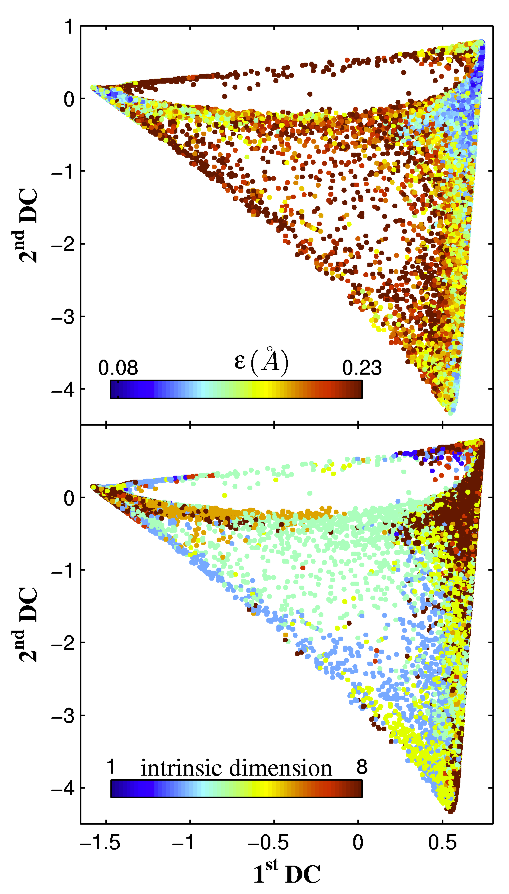 |
Links to pages of interest
CECAM workshopsfrom the connections between the Bellman equation and the Green’s function or fundamental matrix of a Markov Chain. Nonlinearity of the optimization problem and stochasticity of most ingredients in a Markov Decision Processes on the other hand offer new challanges. I will add more to this page as we make progress in this program.
Papers
The most recent work on multiscale/hierarchical representations for MDP’s is this paper: Multiscale Markov Decision Problems: Compression, Solution, and Transfer Learning, J. Bouvrie, M. Maggioni.
A short version is available here: Efficient Solution of Markov Decision Problems with Multiscale Representations, J. Bouvrie and M. Maggioni, Proc. 50th Annual Allerton Conference on Communication, Control, and Computing, 2012.
In these works we introduce an automatic multiscale decomposition of MDP’s, which leads to a hierarchical set of MDP’s “at different scales” and corresponding to different portions of state space, separated by “geometric” and “task-specific” bottlenecks. The hierarchy of nested subproblems is such that each subproblem is itself a general type of MDP, that may be solved independently of the others (thereby giving trivial parallelization), and the solutions may then be stitched together through a certain type of “boundary-conditions”. These boundary conditions are propagated top to bottom, by solving the coarsest problem(s) first, and propagating down the solutions (essentially, these boundary conditions for finer-scale problems), and “filling-in” these coarse solutions by solving the finer problems with the propagated boundary conditions. Besides giving fast parallelizable algorithms for the solution of large MDP’s that are amenable to this decomposition, these decompositions also allow one to perform transfer learning of sub-problems (possibly at different scales), thereby enhancing the possibilities of transferability and power of transfer learning.
Here are electronic copies of two Technical Reports written with my collaborator Sridhar Mahadevan at the Computer Science Dept. at University of Mass. at Amherst about the application of the eigenfunctions of the Laplacian and Diffusion Wavelets to the solution of Markov Decision Processes:
Sridhar and myself organized a workshop on application of spectral methods to Markov Decision Processes, check out the page on our ICML
’06 Workshop to be held during ICML 2006.
Proto-value Functions: A Laplacian Framework for Learning Representation and Control in Markov Decision Processes , with S. Mahadevan. Tech Report Univ. Mass. Amherst, CMPSCI 2006-35, May 2005.
This paper introduces a novel paradigm for solvingMarkov decision processes (MDPs), based on jointly learning representations and optimal policies. Proto-value functions are geometrically customized task-independent basis functions forming the building blocks of all value functions on a given state space graph or manifold. In this first of two papers, proto-value functions are constructed using the eigenfunctions of the (graph or manifold) Laplacian, which can be viewed as undertaking a Fourier analysis on the state space graph. The companion paper (Maggioni and Mahadevan, 2006) investigates building proto-value functions using a multiresolution manifold analysis framework called diffusion wavelets, which is an extension of classical wavelet representations to graphs and manifolds. Proto-value functions combine insights from spectral graph theory, harmonic analysis, and Riemannian manifolds. A novel variant of approximate policy iteration, called representation policy iteration, is described, which combines learning representations and approximately optimal policies. Two strategies for scaling proto-value functions to continuous or large discrete MDPs are described. For continuous domains, the Nystrom extension is used to interpolate Laplacian eigenfunctions to novel states. To handle large structured domains, a hierarchical framework is presented that compactly represents proto-value functions as tensor products of simpler proto-value functions on component subgraphs. A variety of experiments are reported, including perturbation analysis to evaluate parameter sensitivity, and detailed comparisons
of proto-value functions with traditional parametric function approximators.
A Multiscale Framework for Markov Decision Processes using Diffusion Wavelets , with S. Mahadevan. Tech Report Univ. Mass. Amherst, CMPSCI 2006-36. We present a novel hierarchical framework for solving Markov decision processes (MDPs) using a multiscale method called diffusion wavelets. Diffusion wavelet bases significantly differ from the Laplacian eigenfunctions studied in the companion paper (Mahadevan and Maggioni, 2006): the basis functions have compact support, and are inherently multi-scale both spectrally and spatially, and capture localized geometric features of the state space, and of functions on it, at different granularities in space- frequency. Classes of (value) functions that can be compactly represented in diffusion wavelets include piecewise smooth functions. Diffusion wavelets also provide a novel approach to approximate powers of transition matrices. Policy evaluation is usually the expensive step in policy iteration, requiring O(|S|^3) time to directly solve the Bellman equation (where |S| is the number of states for discrete state spaces or sample size in continuous spaces). Diffusion wavelets compactly represent powers of transition matrices, yielding a direct policy evaluation method requiring only O(|S|) complexity in many cases, which is remarkable because the Greenís function (I – P^\pi)-1 is usually a full matrix requiring quadratic space just to store each entry. A range of illustrative examples and experiments, from simple discrete MDPs to classic continuous benchmark tasks like inverted pendulum and mountain car, are used to evaluate the proposed framework.
Value Function Approximation with Diffusion Wavelets and Laplacian Eigenfunctions, with S. Mahadevan. Tech Report Univ. Mass. Amherst, CMPSCI 05-38, May 2005. Analysis of functions of manifolds and graphs is essential in many tasks, such as learning, classification, clustering, and reinforcement learning. The construction of efficient decompositions of functions has till now been quite problematic, and restricted to few choices, such as the eigenfunctions of the Laplacian on a manifold or graph, which has found interesting applications. In this paper we propose a novel paradigm for analysis on manifolds and graphs, based on the recently constructed diffusion wavelets. They allow a coherent and effective multiscale analysis of the space and of functions on the space, and are a promising new tool in classification and learning tasks, in reinforcement learning, among others. In this paper we overview the main motivations behind their introduction, their properties, and sketch a series of applications, among which multiscale document corpora analysis, structural nonlinear denoising of data sets and the tasks of value function approximation and policy evaluation in reinforcement learning, analyzed in two companion papers. The final form of this paper has appeared in the Proc. NIPS 2005, with Sridhar Mahadevan, Tech Report Univ. Mass. Amherst, CMPSCI 05-39, May 2005.
Fast Direct Policy Evaluation using Multiscale Analysis of Markov Diffusion Processes, with Sridhar Mahadevan, accepted to ICML 2006.
Policy evaluation is a critical step in the approximate solution of large Markov decision processes (MDPs), typically requiring $O(|S|^3)$ to directly solve the Bellman system of $|S|$ linear equations (where $|S|$ is the state space size). In this paper we apply a recently introduced multiscale framework for analysis on graphs to design a faster algorithm for policy evaluation. For a fixed policy $\pi$, this framework efficiently constructs a multiscale decomposition of the random walk $P^\pi$ associated with the policy $\pi$. This enables efficiently computing medium and long term state distributions, approximation of value functions, and the {\it direct} computation of the potential operator $(I-\gamma P^\pi)^{-1}$ needed to solve Bellman’s equation. We show that even a preliminary non-optimized version of the solver competes with highly optimized iterative techniques, requiring in many cases a complexity of $O(|S|\log^2 |S|)$.
Learning Representation and Control in Continuous Markov Decision Processes, with Sridhar Mahadevan, Kimberly Ferguson, Sarah Osentoski, accepted to AAAI
2006. This paper presents a novel framework for simultaneously learning representation
and control in continuous Markov decision processes. Our approach builds on the framework of proto-value functions, in which the underlying representation or basis functions are automatically derived from a spectral analysis of the state space manifold. The proto-value functions correspond to the eigenfunctions of the graph Laplacian. We describe an approach to extend the eigenfunctions to novel states using the Nystr¨om extension. A least-squares policy iterationmethod is used to learn the control policy, where the underlying subspace for approximating the value function is spanned by the learned proto-value functions. A detailed set of experiments is presented using classic benchmark tasks, including the inverted pendulum and the mountain car, showing the sensitivity in performance to various parameters, and including comparisons with a parametric radial basis function method
Links
Here are some links to useful pages:
- A Markov
Decision Process Toolbox for Matlab with a quick intro to MDPS,
and various useful links to review papers and books - Another Markov
Decision Process Toolbox for Matlab, by Iadine
Chadès, Marie-Josée
Cros, Frédérick
Garcia, Régis
Sabbadin, at Inria. - Reinforcement
Learning FAQ and Reinforcement
Learning Software and Stuff, by Rich Sutton. - Least-Squares
Policy Iteration code by R. Parr and M.G. Lagoudakis, Duke
University. - An
Introduction to Markov Decision Processes, by B. Givan and R.
Parr. - Online
book on Markov Decision Processes, by Rich Sutton.
Links
2006 NSF Workshop and
Outreach Tutorials on Approximate Dynamic Programming. Check out tutorials and workshop presentations.
People
Links to some people in the field
(this is very very partial list and under continuous construction!):
- Ronald
Parr and Michael G.
Lagoudakis, CS dept. at Duke
University. - Sridhar
Mahadevan at the Computer
Science Dept. at University of Mass. at Amherst . - Andrew
W. Moore, previously at Computer Science
Department of Carnegie Mellon University, now at Google - Silvia
Ferrari at the Laboratory for Intelligent Systems and Controls at Duke University.
- Eric E Monson, Rachael Brady, Guangliang Chen, Mauro Maggioni, Exploration and Representation of Data with Geometric Wavelets, Poster and short paper at Visweek 2010
- G. Chen, M. Maggioni Multiscale Analysis of Plane Arrangements, CVPR, 2011. See also the corresponding poster.
- Other relevant papers.
With many collaborators, we have written several papers during the years, focusing on supervised, semi-supervised and unsupervised algorithms for the analysis of hyperspectral imaging, ranging from automatic segmentation to anomaly detection.
You may find several relevant references on the publication page by clicking “hyperspectral imaging” among the topics at the top:
https://mauromaggioni.duckdns.org/publications/?tgid=35&yr=&type=&usr=&auth=#tppubs
Much of this work focuses on unsupervised learning/clustering/segmentation of hyperspectral images, the use of active learning, and quite a bit on anomaly detection in hyperspectral images and movies. Several of these works have been funded by NSF, DTRA, NGA, in particular by the Anomaly Target Detection program.
————————————————————————————
Here I describe older work, dating to the beginning of the 2000’s, with Raphy Coifman and his research group, and Gus Davis (pathologist) on using DMD mirrors for tuning the light frequency patterns and designing classification algorithms for detection of carcinoma. With light sources of increasingly broader ranges, spectral analysis of tissue sections has evolved from 2 wavelength image subtraction techniques to hyperspectral mapping. A variety of proprietary spectral splitting devices, including prisms and mirror, interferometer, variable interference filter-based monochromometer, tuned liquid crystals, mounted on microscopes in combination with CCD cameras and computers, have been used to discriminate among cell typeS, endogenous, exogenous pigments.
Goals We use a prototype unique tuned light source, a digital mirror array device (Plain Sight Systems) based on micro-optoelectromechanical systems, in combination with analytic algorithms
developed in the Yale Program in Applied Mathematics to evaluate the diagnostic efficiency of hyperspectral microscopic analysis of normal NAD neoplastic colon biopsies prepared as
microarray tissue sections. We compare the results to our previous spectral analysis of colon tissues and to other spectral studies of tissues and cells.
| Experimental Details | |
|---|---|
|
Platform: The prototype tuned light digital mirror array device transilluminates H & E stained micro-array tissue Image Source: 147 (76 normal & 71 malignant) hyperspectral gray Cube: |
|
| Data | |
|---|---|
 |
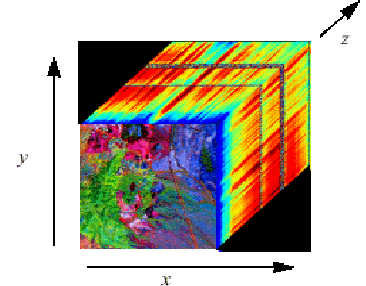 |
|
Figure 2: Microarraybiopsies |
Figure 3: Hyperspectral data cube (image from DataFusion Corp) |
 |
 |
 |
|---|---|---|
|
Average nucleus spectrum with standard |
A spectral slice of a normal gland |
A spectral slice of a cancerous gland |
| TISSUE CLASSIFICATION | |
|---|---|
|
|
|
|
|
|
|
Tissue classification algorithm on a sample |
Tissue classification algorithm on a sample |
| ALGORITHM FOR NORMAL/ABNORMAL DISCRIMINATION |
|
|---|---|
 |
 |
|
Normal: GREEN – true negative (normal classified as |
Abnormal: GREEN – false negative (abnormal classified as |
|
Table 1: |
||
| Patches/Nuclei (8688) | True Positive (4860) | True Negative (3828) |
|---|---|---|
| Predicted Positive ( malignant) |
94.0% (4568) |
7.3% (280) |
|
Predicted Negative normal) |
6.0% (292) |
92.7% (3548) |
| CLASSIFICATION OF A WHOLE SLIDE |
|
|---|---|
| The classification of a whole slide is obtained by selecting 40 random nuclei patches from the slide, and averaging the corresponding classifications. The classification of the slides has no mistakes, since the few errors of classification on the nuclei are averaged out on the whole slide. |
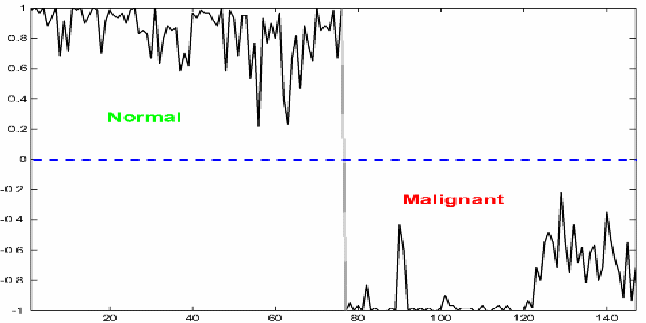 |
| A SPATIAL-SPECTRAL CLASSIFIER |
|
|---|---|
 |
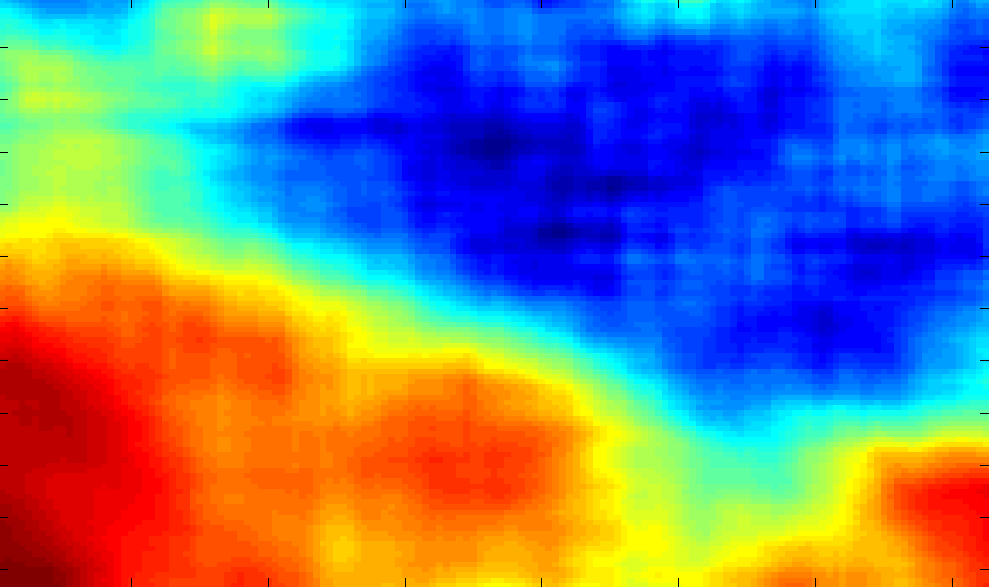 |
Papers
- Hyperspectral pathology:
- Hyper-spectral microscopic discrimination between normal and cancerous colon biopsies. Franco Woolfe, Mauro Maggioni, Gustave Davis, Frederick Warner, Ronald Coifman, and Steven Zucker, submitted, 2006.
- Algorithms from Signal and Data Processing Applied to Hyperspectral Analysis: Discriminating Normal and Malignant Microarray Colon Tissue Sections Using a Novel Digital Mirror Device System.
M.Maggioni, G.L. Davis, F. J. Warner, F. B. Geshwind, A.C. Coppi, R.A.DeVerse, R.R.Coifman, Tech Report, Dept. Comp. Science, Yale University,. November 2004. - Hyper-spectral Analysis of normal and malignant colon tissue microarray sections using a novel DMD system, G. L. Davis, M. Maggioni, F. J. Warner, F. B. Geshwind, A. C. Coppi, R. A. DeVerse, R. Coifman, poster session at Optical Imaging NIH workshop, Sep. 2004.
- ,Hyper-Spectral analysis of normal and malignant microarray tissue sections using a novel micro-optoelectricalmechanical system G.L. Davis, M. Maggioni, F. J. Warner, F. B. Geshwind, A.C. Coppi, R.A. DeVerse, R.R.Coifman.
- Spatial-Spectral Analysis of Colon Carcinoma, G.L. Davis, R.R.Coifman, R.Levinson.
- Target and anomaly detection
- With connections to compressed sensing and estimation of probability measures: A Fast Multiscale Framework for Data in High Dimensions: Measure Estimation, Anomaly Detection, and Compressive Measurements, G. Chen and M. Iwen and S. Chin and M. Maggioni, Visual Communications and Image Processing (VCIP), Nov. 2012 IEEE (submitted April 2012, published version available here).
As an undergraduate students I studied wavelets under the guidance of Prof. Maurizio Soardi at the Universita’ degli Studi of Milano (now at the Bicocca site); I constructed some new biorthogonal wavelets, with dilation factors 2 and 3.
As a graduate student I studied harmonic analysis and wavelets under the guidance of Prof. Guido Weiss at Washington University in St. Louis; I constructed wavelet frames the discretize continuous wavelet transforms obtained from representations theory of groups and decompositions of unity on hypergroups.




